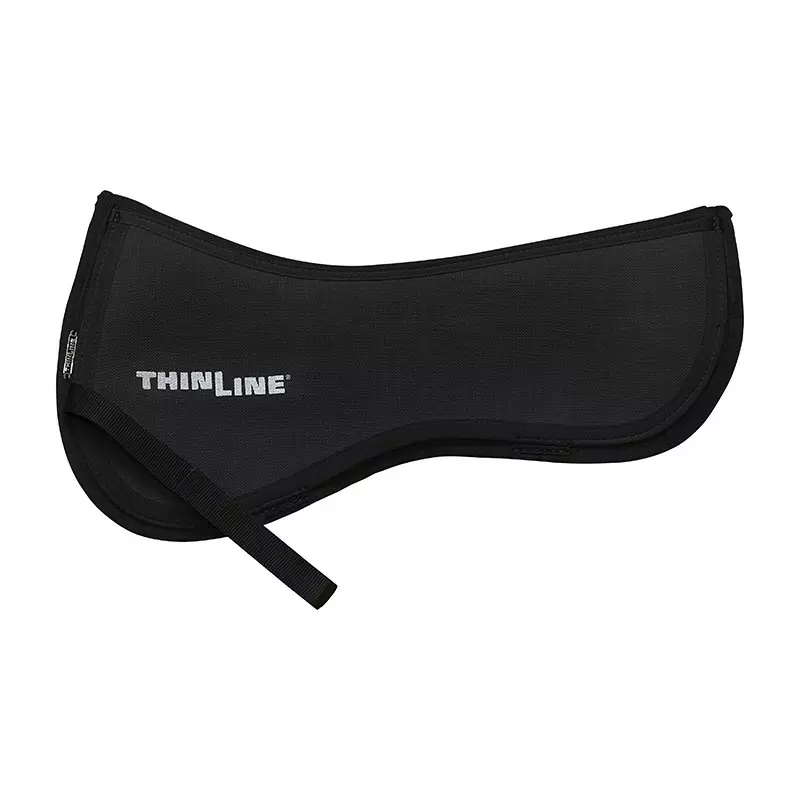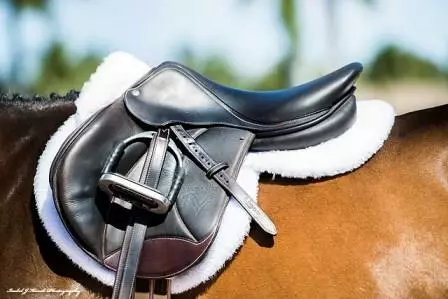For many riding disciplines, half pads enhance saddle fit and comfort. In this article, we’ll explore the versatility and function of half pads and their role in improving saddle stability and fit, which can change substantially as a horse’s body develops with work and training.
Additionally, we’ll discuss the different styles of half pads, the materials used in their construction, how they influence pressure distribution, and why this matters. We’ll also discuss how they contribute to better rider and horse performance. Sharing this information can assist riders in choosing and using half pads effectively.
Points To Note
- Half pads are a helpful option when fitting a saddle to a horse. They can improve the horse’s comfort and rider’s performance by compensating for changes in the horse’s body, ensuring proper saddle balance, and distributing pressure more evenly.
- Half pads can provide customized support for a horse. Pressure testing results can determine which pads are most effective in achieving optimum comfort so a horse can perform its best.
Understanding Half Pads
Correcting any imbalance that could cause pressure points and pain is vital during saddle fitting. With this in mind, half pads are often used to correct such problems. By adding an extra layer of cushioning between the horse’s back and the saddle, the right pad can help achieve better saddle balance, comfort, and performance.
Experienced riders and saddle fitters often use half pads to adjust saddle fit, as a horse’s musculature can change with time, exercise, and training.
Half pads allow close contact with the horse while ensuring uniform weight distribution beneath the saddle, thus avoiding localized pressure that could restrict a horse’s natural movement.

Study Findings Overview
While adjusting saddle fit and enhancing equine comfort are critical uses of half pads, recent studies (Example: https://thehorse.com/1104553/study-half-pads-arent-always-helpful/) shed light on their effectiveness and possible impact on a horse’s movement. These studies have generated helpful data to guide which type of half pad a rider should use.
Here are some significant findings:
- Pressure Distribution: Half pads can help spread pressure evenly across a horse’s back.
- Saddle Stability: With the correct half pad, saddle stability can improve, reducing the chances of slippage and providing extra cushioning without compromising the fit.
- Equine Performance: The choice of half pad material can significantly affect horse comfort and, as a result, performance. Some materials may intensify pressure points, while others may help to relieve them.
Pressure Testing Methodology
In assessing the effectiveness of half pads, scientists used pressure testing to gauge the spread of forces on a horse’s back during various riding exercises and with different types of pads. The pressure testing approach provided quantitative data demonstrating how a half pad can change the pressures exerted by the saddle and rider.
This scientific technique is key for a saddle fitter to decide whether a saddle pad alone or combined with a half pad results in a properly fitted saddle. By analyzing the pressure distribution, saddle fitters can recommend to riders the appropriate type of half pad to use, ensuring the horse’s comfort and performance are maintained.
This empirical data supports the saddle fitting process, emphasizing the need for a tailored approach for each horse and rider combination.
Saddle Fitting Considerations
Considering the empirical data from pressure testing, saddle fitting must consider the type and thickness of half pads used to ensure they do not negatively impact the distribution of forces on the horse’s back. A professional saddle fitter will assess the following:
- Saddle Panels – Ensure the panels match the horse’s back contour with consistent contact and avoid pressure points.
- Horse’s Withers – Verify that there is adequate space above the withers and along the spine to prevent chafing and compression and permit free movement.
- Clear Gullet – Ensure that a half pad does not reduce the gullet space, preventing stress on the horse’s spine.
An experienced saddle fitter will employ these considerations to achieve the best saddle fit, improving the horse’s comfort and the rider’s security.
Material and Design Varieties
Various materials and designs of half pads are on the market, each tailored to satisfy distinct equestrian needs and preferences.
Memory foam half pads are popular for their ability to mold to the horse’s back, providing a personalized fit that can absorb shock and distribute weight uniformly. However, when memory foam compresses over time due to the rider’s weight, it loses effectiveness, and the compressed foam creates pressure points.
Wool pads are often chosen for their breathability and natural cushioning, offering a time-tested padding option that continues to be esteemed for its long-lasting use and comfort.
Along with wool, sheepskin is a natural cushioning that offers good shock absorption and pressure reduction, but too much of sheepskin can produce movement. ThinLine’s Full Sheepskin Trifecta stops any movement and greatly reduces impact and pressure points.
Alternatively, half pads incorporating gel pad inserts or shims are used for extra shock absorption. However, the nature of the gel material makes them prone to creating pressure points, primarily in the wither area.
Each material offers distinct advantages, and selecting a half pad should consider the horse’s shape, how well the regular saddle pad fits, and the type of riding to be done.
ThinLine is the only product that won’t alter saddle fit or create pressure points. Additionally, it’s the only one that provides impact protection for both the horse and rider, as well as rider/saddle stability while decreasing pressure peaks.
Correcting Saddle Balance
Half pads can effectively correct imbalances in saddle fit. They offer a means to level or stabilize an ill-fitting saddle, avoiding immediate, expensive adjustments or replacement saddles. \
When a saddle does not sit correctly, it can impede a horse’s movement and lead to discomfort and potentially injury. ThinLine’s shimmable half pads are ideal for resolving saddle imbalance or fit problems that arise from equine conformational asymmetry.
A half pad chosen with guidance from a professional saddle fitter can rectify saddle balance. Unlike a regular saddle pad, which cushions and protects the saddle from dirt and sweat, a half pad specifically addresses and amends the distribution of the saddle’s pressure.
It offers necessary support in areas where the saddle may tip forward or backward, aiding in maintaining an optimal position for the rider and ensuring the horse’s comfort and performance remain unaffected.

Adjusting to Horse Changes
As horses grow and their body shapes change, a half pad can be very helpful in adjusting how the saddle fits their new outlines. The relationship between a horse’s altered form and saddle compatibility is a sensitive equilibrium that calls for careful modification. A half pad used under the saddle can act as an adaptable buffer, addressing fit challenges as a horse matures, builds muscle, or loses weight.
Here are three key considerations:
- Monitoring Development: As horses age or go through training, their muscle structure can transform, which means regular checks of saddle fit by a specialist are necessary.
- Flexible Fitting: A half pad can provide a temporary solution to help the saddle fit better for minor changes in a horse’s topline without the immediate need to restuff the saddle or buy a new one.
- Enhancing Comfort: For horses whose shape has become constant, a half pad can improve comfort and help distribute the saddle’s weight more evenly, especially if the saddle does not fit the horse’s back as well as it once did.
Enhancing Rider Comfort
We must also consider that beyond accommodating the horse’s changing body, a half pad can significantly enhance comfort for riders during long hours in the saddle or for dressage or jumper riders whose bodies continually absorb shock.
The strategic placement of a half pad offers additional cushioning that can absorb impact and reduce fatigue. This extra cushioning effect is not just beneficial for the horse but also for the rider, as it can lead to a more harmonious and less jarring riding experience, a welcome respite for riders struggling with back or neck issues. ThinLine half pads are the only ones endorsed by spinal surgeon James Warson, MD, in his book, The Rider’s Pain-Free Back.
Improved rider comfort is paramount for both casual rides and competitive scenarios, where the rider’s strength, endurance, and focus are tested.
While this is generally not a consideration for riders and horse owners when choosing a half pad, nonetheless, it is a valuable benefit.
Summary Of Case Studies and Outcomes
In equestrian sports, studies focusing on the use of half pads have provided significant findings regarding horse comfort and rider performance. These studies highlight the need for the perfect fit and the importance of saddle fitters in achieving this aim.
Here are the main outcomes:
- Half pads offer necessary cushioning that can improve comfort for competition horses, lessening the likelihood of back soreness and enhancing performance.
- A professional saddle fitter can recommend the most appropriate half pad for improving saddle fit, thus helping to prevent movement restrictions and potential injuries.
- The impact and effectiveness of half pads depend on their material and construction, underscoring the need for professional assessment to ensure a positive effect for both horse and rider.
Frequently Asked Questions
Can the Use of a Half Pad Replace the Need for Professional Saddle Fitting Services?
While a half pad may serve as a temporary fix to minor saddle fitting problems, it is not a substitute for the expertise of professional saddle fitting services, which are key to ensuring the long-term well-being, safety, and performance of both horse and rider.
How Often Should a Half Pad Be Replaced to Maintain Its Effectiveness and Support?
The frequency with which you should replace a half pad varies based on the type of material and how often it is used. Inspect the half pad regularly for wear and compression, and pay attention to changes in your horse’s attitude and way of going under saddle. The life of a ThinLine half pad is seven to ten years.
Are There Any Specific Riding Disciplines Where Half Pads Should Not Be Used, or Are They Universally Beneficial?
In certain equestrian disciplines where maintaining a close feel of the horse is important, riders may choose not to use half pads due to their added thickness. However, ThinLine half pads, as the name implies, are so thin and shock-absorbing that they actually improve a rider’s feel.
Can Half Pads Create Issues With Heat Build-Up and Sweating on the Horse’s Back?
Half pads might lead to increased warmth and moisture during long or hot riding sessions, depending on the material they’re made of. ThinLine pads have a mesh spine, which promotes ventilation.
How Does the Weight of the Rider Influence the Selection and Necessity of a Half Pad?
The weight of the rider plays a significant role in determining whether a half pad is necessary, as it affects how pressure is distributed and the comfort level of the horse. This necessitates carefully selecting a half pad to suit individual needs and ensure proper saddle fit.
Final Points
The right half pad acts as an important supplement to saddle fitting, enhancing the comfort of the horse and the performance of the rider. They adjust for changes in a horse’s body shape, ensure proper saddle balance, and help to spread out pressure more evenly.
Choosing the right materials and styles, guided by pressure testing and empirical evidence, offers customized support for each horse. The practical use of half pads, as shown in specific examples, supports their importance in protecting the well-being of horses and improving riding activities.

